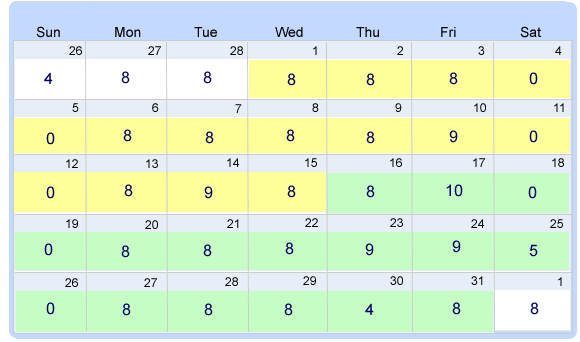FLSA Overtime Calculator Advisor
Hours Worked in the Workweek
Example
March 2006

The employee in this example is paid a salary on a semi-monthly pay period and the employee’s workweek is a calendar workweek (Sunday through Saturday).
Pay Period One (March 1 – March 15) includes hours worked in Workweeks 1, 2 and 3:
Workweek 1* |
(Feb. 26 – Mar 4) |
Workweek 2 |
(Mar 5 – Mar 11) |
Workweek 3 |
(Mar 12 – Mar 18) |
Pay Period Two (March 16 – March 31) includes hours worked in Workweeks 3, 4 and 5:
Workweek 3 |
(Mar 12 – Mar 18) |
Workweek 4 |
(Mar 19 – Mar 25) |
Workweek 5** |
(Mar 26 – April 1) |
*Workweek 1 includes some hours worked for which the employee was paid in the previous pay period.
**Workweek 5 also includes some hours worked for which the employee will be paid in the next pay period.
For Workweek 1 the employee worked 20 hours (worked February 26-28) in the preceding pay period. Although the employee’s earnings for the earlier pay period included straight-time pay for these 20 hours (worked February 26-28), the hours must also be included in the total for Workweek 1 of this pay period to determine if overtime pay is due for Workweek 1. The employee worked a total of 44 hours for the workweek so overtime pay is due for the 4 hours worked in excess of 40.
The total hours worked in each workweek for both pay periods are as follows:
Pay Period One (March 1 - March 15):
Workweek 1 |
(Feb. 26 – Mar 4) |
44 hours, overtime pay due for 4 hours |
Workweek 2 |
(Mar 5 – Mar 11) |
41 hours, overtime pay due for 1 hour |
Pay Period Two (March 16 - March 31):
Workweek 3 |
(Mar 12 – Mar 18) |
43 hours, overtime pay due for 3 hours |
Workweek 4 |
(Mar 19 – Mar 25) |
47 hours, overtime pay due for 7 hours |
Workweek 5 |
(Mar 26 – April 1) |
44 hours, overtime pay due for 4 hours |
In Workweek 2 the employee worked 1 overtime hour. In Workweek 3 the employee worked a total of 43 hours, including 3 overtime hours. Hours worked on March 13, 14, and 15 in Workweek 3 were paid at a straight-time rate in Pay Period One. However, the employee is still due the additional overtime pay (one-half his or her regular rate of pay, times overtime hours for the overtime worked in Workweek 3) with receipt of his or her regular earnings for Pay Period Two.
Workweek 5 also includes hours worked outside the pay period, minus 8 hours worked on April 1. Since the total hours worked for this workweek is 44, overtime pay is due for 4 hours. However, because the time cuts across two pay periods, the additional pay for overtime hours worked will be due with the employee’s regular earnings for the following pay period.
If the employee in this example was paid a monthly salary, instead of semi-monthly, overtime pay would be calculated in the same way. First, the workweek must be determined and hours worked totaled for each workweek. Overtime pay is then calculated based on the total number of hours worked in each workweek, even when those workweeks cut across pay periods. An employee whose workweek is a calendar week, who is paid a monthly salary and who worked the hours indicated on the calendar above, would have worked more than 40 hours in each of the 5 workweeks represented. Workweeks 1 and 5 would have hours worked, including overtime hours, which cut across pay periods.
 U.S. Department of Labor
U.S. Department of Labor
